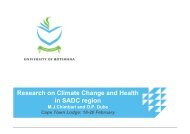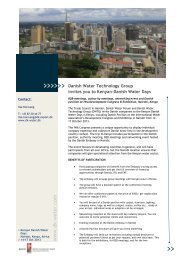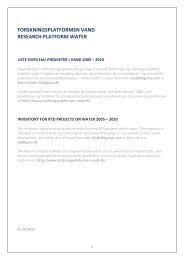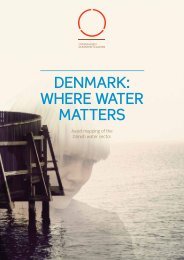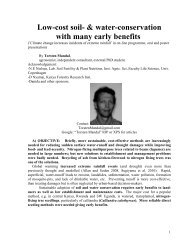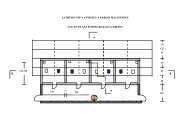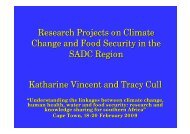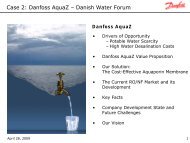Wizards of the water cycle
Wizards of the water cycle
Wizards of the water cycle
- No tags were found...
You also want an ePaper? Increase the reach of your titles
YUMPU automatically turns print PDFs into web optimized ePapers that Google loves.
s p e c i a l r e p o r t n w a t e r v s. e n e r g yILLUSTRATION: BRANDON PALACIO; MAP: ANDREW ZBIHLYJSun, an associate pr<strong>of</strong>essor <strong>of</strong> civil andenvironmental engineering at NanyangTechnological University, in Singapore,has seen an uptick in interest in his workon energy-efficient membranes. “In most<strong>water</strong> engineering, people didn’t careabout how much energy goes in—untilrecently. The energy crisis made thisa critical issue,” he says. Sun is investigatinga membrane design that usestitanium-dioxide nan<strong>of</strong>ibers to filter <strong>water</strong>and generate electricity simultaneously.But <strong>the</strong> research is far from mature,so for now <strong>the</strong> energy cost will remainhigh. That’s <strong>the</strong> price Singapore mustpay for a first-rate <strong>water</strong> supply and ahealthy country, says Kallidaikurichi.“You may argue that <strong>water</strong> here consumesmore energy, but <strong>the</strong> city needsmore <strong>water</strong>, because it’s <strong>the</strong> city that’sproducing more wealth.”The solution to making <strong>the</strong> trade-<strong>of</strong>fwork, say Biswas and Kallidaikurichi, ispurely economic: Singapore charges allits customers <strong>the</strong> marginal cost <strong>of</strong> <strong>water</strong>—that is, <strong>the</strong> cost <strong>of</strong> producing ano<strong>the</strong>r liter.For Singapore, that means desalination.So <strong>the</strong> Public Utilities Board has set<strong>the</strong> price <strong>of</strong> <strong>water</strong> to pay for its energyintensiveoperations.As a result, <strong>the</strong> utility has enough cashto investigate new technologies. Seahwould like to cut <strong>the</strong> energy needed fordesalination by more than half, to 1.5 kWhper thousand liters, and <strong>the</strong> energy forNEWater to 0.4 kWh from 0.7 kWh.He ’s opt i m ist ic. A f ter a l l, t heNEWater processes would have consumedmore energy per liter had hisengineers not experimented with <strong>the</strong>m.“The technologies came from everywhere,but I think our value is in how weexploit <strong>the</strong>m,” Seah says. “How we put<strong>the</strong>m toge<strong>the</strong>r. How we wrote <strong>the</strong> s<strong>of</strong>tware.How we operate <strong>the</strong> plants.”For example, he and his colleaguesfound a way to introduce a bit <strong>of</strong> chloramine,a disinfectant, into <strong>the</strong> membranefi lt r at ion pro cess. T hat add it ionprevents <strong>the</strong> pores from clogging withoutdegrading <strong>the</strong> membrane material—achallenge that had stymied <strong>the</strong>industry for some time. Clogged poresmean more pressure to drive <strong>the</strong> <strong>water</strong>through, with a larger electricity bill asa result. Similarly, <strong>the</strong> utility’s engineershave found a way to use less pressurein operating a membrane bioreactor, amachine containing swarms <strong>of</strong> microorganismsthat snack on contaminantsin <strong>the</strong> <strong>water</strong>. That innovation will soonreplace <strong>the</strong> first filtration step, makingNEWater about 20 percent cheaper toproduce, Seah says.O<strong>the</strong>r innovations are likely to trickleout <strong>of</strong> Singapore’s <strong>water</strong> sector, as companiesand academics seek to pr<strong>of</strong>itfrom <strong>the</strong> <strong>water</strong> utility’s interest in innovation.For example, researchers underSay Leong Ong, acting head <strong>of</strong> <strong>the</strong> environmentalsciences and engineeringdivision at <strong>the</strong> National University <strong>of</strong>Singapore, are figuring out <strong>the</strong> mechanismsused by mangrove trees andtilapia fish to process <strong>the</strong> salt in sea<strong>water</strong>,with <strong>the</strong> hope <strong>of</strong> one day designingmembranes that mimic nature.Ultimately, Singapore will have true<strong>water</strong> security only if it can reduce itsdependence on imported energy. A civilization’ssurplus energy, arising fromits trade and technological prowess, isReservoirsNEWater Plant77 ML/dayWater importedfrom MalaysiaPoweredByCrazyFree eNergy? uriNe lucK!you may not think <strong>of</strong> urine as avaluable resource—quite <strong>the</strong>opposite, probably—but ohiouniversity chemical engineergerardine Botte has come upwith a way to harness it forgood. Botte’s technologyefficiently produceshydrogen for fuel-cellpoweredcars, from urine.dry out that urine and you’re left with acompound called urea, a single molecule <strong>of</strong>which contains four hydrogen atoms. <strong>the</strong>bonds that bind urea’s hydrogen are mucheasier to break than <strong>the</strong> hydrogen bonds in<strong>water</strong>, which is typically used as <strong>the</strong> sourcefor hydrogen in fuel cells. experimentingwith human urine, Botte showed thatapplying a mere 0.37 volt did <strong>the</strong> trick,much less than <strong>the</strong> 1.23 V required to split<strong>water</strong>. What’s more, urea yields twice asmuch hydrogen per molecule.Botte’s research might lead to cheaperhydrogen for fuel cells as well as cheaperwaste<strong>water</strong> purification: a scaled-up version<strong>of</strong> <strong>the</strong> technology could generate hydrogenwhile treating sewage.—Sally Adeewhat allows an economy to shift investmentaway from life-critical needs such as<strong>water</strong> to education, art, and a rich civic life.An energy-secure <strong>water</strong> sector, <strong>the</strong>n, willbe a major question for <strong>the</strong> next 50 years<strong>of</strong> <strong>the</strong> tiny island’s nationhood. ❏NEWater Plant23 ML/dayPacificO ceanI n d I aArea <strong>of</strong>detailC h I n aNOT JUSTTOILETS...NEWaterplants andreservoirsdot <strong>the</strong> island, providing anengineered stand-in for <strong>the</strong>ground<strong>water</strong> Singapore lacks.DesalinationPlantSouth TunnelSewerage System(incomplete)NEWater Plant145 ML/dayNorth TunnelSewerage SystemNEWater Plant82 ML/dayNEWater Plant227 ML/dayspectrum.ieee.orgieee spectrum • nA 61



